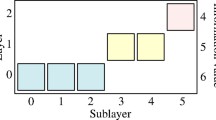Abstract
We propose a layered multicast transmission scheme with superposition coding for cellular systems, i.e., at a base station a basic multicast stream (BMS) and an enhanced multicast stream (EMS) are superimposed and transmitted, the same BMS is repeatedly transmitted multiple times to ensure most users in the cell receive basic qualities of the service, while in each transmission different EMSs are transmitted to make the users with good channel conditions receive higher qualities of the service. In this paper, the optimal joint rate and power allocation for the layered multicast scheme is studied. Specifically, we first give a proof on the claim that the system delay of a BMS is minimized if the transmission rate of the BMS is set according to a fixed user selection ratio in each transmission. Then subject to fixed transmit power and power allocation, we derive the optimal transmission rate of a BMS that minimizes the system delay of the BMS, and the optimal transmission rate of an EMS that maximizes the average throughput of the EMS. Finally, by balancing the tradeoff between the system delay of a BMS and the average throughput of an EMS, we find the optimal joint rate and power allocation for the layered multicast scheme. Numerical results show that the optimized layered multicast scheme outperforms the conventional schemes in terms of the system delay of a BMS and the average throughput of an EMS.








Similar content being viewed by others
References
Faria, G., Henriksson, J. A., Stare, E., & Talmola, P. (2006). DVB-H: Digital broadcast services to handheld devices. Proceedings of the IEEE, 94(1), 194–209.
Chuberre, N. et al. (2004). Satellite digital multimedia broadcasting for 3G and beyond 3G systems. In Proceedings of 13th IST Mobile and Wireless Communications. Summit, Lyon, France.
3GPP TR 25.992 V6.0.0. (2003). Multimedia broadcast/multicast service (MBMS); UTRAN/GERAN requirements.
3GPP2 Std. C.S-0054-A. (2006). Cdma2000 high rate broadcast-multicast packet data air interface specification, Revision A.
Jiang, T., Xiang, W., Chen, H., & Ni, Q. (2007). Multicast broadcast services support in OFDMA-based WiMAX systems. IEEE Communications Magazine, 45(8), 78–86.
Wei, D., Wang, W., Peng, M., Liang, D., & Liu, Y. (2011). The performance of layered broadcast with superposition coding. International Journal of Communication Systems, 24(7), 911–924.
Liu, Y., Wang, W., Peng, M., & Wei, D. (2009). Mixed multicast and unicast transmission by superposition coding over Nakagami-m fading channels. International Journal Wireless Communincations and Networking, 2(1), 95–104.
Gopala, P. K., & Gamal, H. E. (2004). Opportunistic multicasting. In Proc. IEEE 38th Asilomar conf. signals, systems and computers (pp. 845-849). USA: Pacific Grove.
Koh, C. H., & Kim, Y. Y. (2006). A proportional fair scheduling for multicast services in wireless cellular networks. In Proc. IEEE VTC-Fall (pp. 1–5). Montreal, Canada.
Low, T. P., Pun, M. O., Hong, Y. -W. P., & Kuo, C.-C. J. (2010). Optimized opportunistic multicast scheduling (OMS) over wireless cellular networks. IEEE Transactions on Wireless Communications, 9(2), 791–801.
Low, T. P., Pun, M. O., & Kuo, C.-C. J. (2008). Optimized opportunistic multicast scheduling over cellular networks. In Proc. IEEE GLOBECOM (pp. 1–5). New Orleans, USA.
Huang, W., & Yeung, K. L. (2010). Optimal opportunistic multicast for minimizing broadcast latency in wireless networks. In Proc. IEEE ICC (pp. 1–5). Cape Town, South Africa.
Park, S. Y., & Love, D. J. (2009). Outage performance of multi-antenna multicasting for wireless networks. IEEE Transactions on Wireless Communications, 8(4), 1996–2005.
Ntranos, V., Sidiropoulos, N. D., & Tassiulas, L. (2009). On multicast beamforming for minimum outage. IEEE Transactions on Wireless Communications, 8(6), 3172–3181.
Liu, Y., Wang, W., Peng, M., & Zhu, S. (2010). Optimized layered multicast with superposition coding in cellular systems. Wireless Communications and Mobile Computing, http://onlinelibrary.wiley.com/journal/10.1002/(ISSN)1530-8677/earlyview.
Cover, T. M., & Thomas, J. A. (1991). Elements of information theory. New York: Wiley
Baek, S. Y., Hong, Y. J., & Sung, D. K. (2009). Adaptive transmission scheme for mixed multicast and unicast traffic in cellular systems. IEEE Transactions on Vehicular Technology, 58(6), 2899–2908.
Acknowledgments
This work was supported in part by the Fundamental Research Funds for the Central Universities under Grant No. 2011RC2J12, the National High-Tech R&D 863 Program of China under Grant No. 2009AA01Z244, and by the National Sci-Tech Major Projects under Grant No. 2010ZX03003-003-01 and 2010ZX03005-002-02.
Author information
Authors and Affiliations
Corresponding author
Rights and permissions
About this article
Cite this article
Liu, Y., Wang, W., Peng, M. et al. Optimal joint rate and power allocation for layered multicast with superposition coding in cellular systems. Wireless Netw 19, 69–81 (2013). https://doi.org/10.1007/s11276-012-0451-2
Published:
Issue Date:
DOI: https://doi.org/10.1007/s11276-012-0451-2




